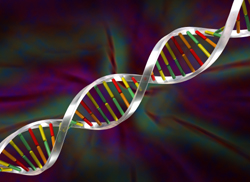Telomere association with DNA repair proteins
The function of the telomere in ageing, DNA repair, and sensitivity to ionising radiation has attracted many research projects. One of these, the EU funded TELOSENS has investigated the role of telomere integrity in relation to radiation carcinogenesis. Specifically, partners at the Spanish National Cancer Centre, CNIO, focused on the role of DNA repair proteins in telomere maintenance. Four proteins in particular were shown in previous research by scientists at CNIO to play a role in telomere length and capping. The relationship between the enzyme telomerase and these proteins was further determined by breeding mice doubly deficient for the gene responsible for the protein in question and telomerase. One protein, PARP Poly (ADP-ribose) polymerase, was investigated in conjunction with another project partner, ENSL in Lyon. A functional relationship at mammalian level was found between PARP and a telomere binding protein, telomeric repeat binding factor 2 (TRF2). The TRF2 protein in particular yielded an interesting insight into the relationship of the telomere with DNA repair mechanisms. To investigate the theory that TRF2 repressed DNA repair, specifically at the telomeres, the scientists generated mice with increased expression of the protein under the keratin-5 promoter. These K5-TRF2 mice exhibited age-related skin disorders including skin hyperpigmentation, and neoplastic lesions. When studied at molecular level, the keratinocytes showed drastic changes to the telomere including shortening together with chromosome instability. Furthermore, K5-TRF2 mice showed increased sensitivity to ultraviolet radiation and DNA agents giving rise to cross-linking of the DNA structure. Cross-linking results in the DNA double helix strands being prevented from separating for synthesis or transcription. The skin phenotype of the K5-TRF2 mice is reminiscent of the skin condition xeroderma pigmentosum. Defective DNA repair and shortened telomeres aggravated by the absence of telomerase is thought to give rise to these UV sensitive individuals. The work of these TELOSENS partners has defined TRF2 as playing a major role in DNA repair and telomere integrity. As such, further research may help elucidate cellular responses to ionising radiation.







